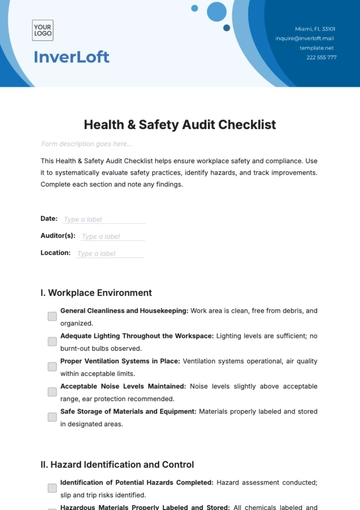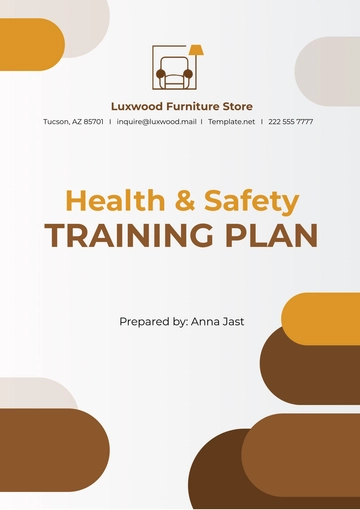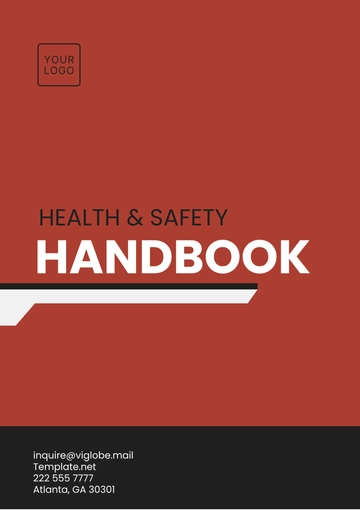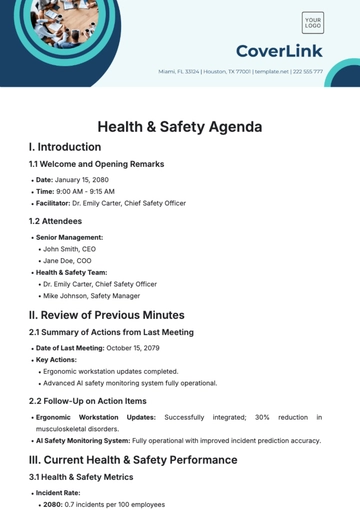Free Health & Safety Legal Protocol Development

I. Introduction
A. Purpose of the Health & Safety Legal Protocol
The purpose of this protocol is to establish a framework for identifying, assessing, and mitigating health and safety risks. By implementing this protocol, we aim to create a culture of safety, reduce the likelihood of accidents, and adhere to legal requirements.
B. Legal Framework
Identification of Applicable Laws and Regulations
We are committed to upholding the highest standards of health and safety, and this commitment is reflected in our strict adherence to a comprehensive array of legal requirements. Our organization abides by key federal regulations such as the Occupational Safety and Health Act (OSHA), the Americans with Disabilities Act (ADA), and the Environmental Protection Act. In addition to these, we comply with relevant state and local health and safety laws.
Commitment to Legal Compliance
[Your Company Name] is dedicated to upholding the highest standards of legal compliance. We commit to regularly monitoring and updating our protocol to align with any changes in legislation.
II. Policy Statements
A. General Health and Safety Policy
At [Your Company Name], safety is our cornerstone. Our policy prioritizes a proactive approach to identify and manage risks, ensuring a secure work environment for all. We are committed to fostering a culture that values health and safety as integral to our organizational ethos.
B. Responsibilities of Management
Leadership at [Your Company Name] commits to providing resources, support, and guidance for the successful implementation of health and safety measures, reinforcing our dedication to employee well-being.
C. Employee Responsibilities
Every employee plays a vital role in maintaining a safe workplace by adhering to protocols, reporting hazards promptly, and actively participating in training initiatives. Our collective responsibility ensures a secure and healthy work environment.
D. Commitment to Continuous Improvement
At [Your Company Name], we embrace a culture of continuous improvement in health and safety. Feedback from employees and incident analyses drive ongoing enhancements to our protocols, fostering a dynamic and responsive safety environment.
III. Risk Assessment
A. Hazard Identification
Our systematic hazard identification process covers all aspects of our organization, ensuring a comprehensive understanding of potential risks that might impact our employees, visitors, and stakeholders.
B. Risk Evaluation and Prioritization
Each identified hazard undergoes a thorough evaluation, considering likelihood and severity. This information guides the prioritization of risks, directing our resources toward mitigating the most significant threats.
C. Risk Mitigation Strategies
We implement a multifaceted approach to risk mitigation, including engineering controls, administrative measures, and the provision of personal protective equipment. This ensures a layered defense against potential risks.
D. Periodic Review and Update of Risk Assessment
Regular reviews of our risk assessment process guarantee that it remains current and aligned with the dynamic nature of our organization. This iterative approach allows for timely adjustments to our risk mitigation strategies.
IV. Health & Safety Procedures
A. Emergency Response Procedures
Our emergency response procedures include well-defined evacuation plans and first aid protocols, emphasizing the safety of our personnel. Regular drills and training sessions ensure preparedness and swift, effective responses to unforeseen events.
B. Incident Reporting and Investigation
Prompt and thorough incident reporting is encouraged. Our investigation process aims to identify root causes and implement corrective actions swiftly, promoting a culture of transparency and continuous improvement.
C. Workplace Inspections and Audits
Regular inspections and audits are conducted to identify potential hazards, ensuring a proactive stance in maintaining a safe environment. Findings are documented, and corrective actions are promptly implemented to enhance workplace safety.
D. Personal Protective Equipment (PPE)
Employees are provided with suitable PPE, and guidelines for its use are clearly communicated. Regular assessments guarantee the continued effectiveness of our PPE provisions in safeguarding personnel.
E. Workstation Ergonomics
Our guidelines for ergonomic workstations are designed to prevent musculoskeletal issues, promoting the well-being of our employees. Education on proper ergonomic practices ensures sustained health and comfort in the workplace.
F. Hazardous Materials Handling and Storage
Procedures for the safe handling, storage, and disposal of hazardous materials are strictly adhered to, in compliance with regulatory requirements. Our commitment to environmental and employee safety guides these critical processes.
V. Training and Awareness
A. Employee Training Programs
Comprehensive training programs empower employees with the knowledge to identify and mitigate risks. Regular sessions foster a culture of safety consciousness, ensuring that all personnel are equipped to navigate potential hazards confidently.
B. Communication of Health & Safety Information
Clear communication channels are established to disseminate crucial health and safety information efficiently. Regular updates and reminders ensure that everyone remains informed about protocols, fostering a shared responsibility for a secure workplace.
C. New Employee Orientation
Our thorough new employee orientation includes comprehensive health and safety training, integrating newcomers seamlessly into our safety-conscious culture from day one.
D. Periodic Refresher Training
Regular refresher training sessions reinforce key health and safety principles, ensuring that our workforce stays current with best practices and remains vigilant in maintaining a secure work environment.
E. Promotion of Health & Safety Culture
Initiatives such as recognition programs and safety committees actively promote a robust health and safety culture. Regular communication and engagement activities strengthen our collective commitment to a safe and secure workplace.
VI. Legal Compliance
A. Regular Legal Compliance Audits
Periodic audits systematically assess our compliance with health and safety laws, facilitating prompt adjustments to protocols. Our proactive approach ensures that we stay ahead of regulatory changes and maintain a steadfast commitment to legal requirements.
B. Documentation of Compliance Efforts
Comprehensive records meticulously document our compliance efforts, including audit reports and corrective actions. This detailed documentation serves as a tangible demonstration of our commitment to meeting and exceeding legal standards.
C. Communication with Regulatory Authorities
Established communication channels with regulatory authorities facilitate transparent reporting and collaboration. Open dialogue ensures that we remain aligned with regulatory expectations and contribute to the ongoing improvement of industry standards.
VII. Record-Keeping
A. Incident and Near-Miss Reports
Thorough documentation of incidents and near-misses, along with detailed investigations, provides valuable data for continuous improvement. This record-keeping approach enables us to identify trends and implement preventive measures effectively.
B. Training Records
Detailed records of employee training, including content and attendance, are maintained meticulously. This organized approach serves as tangible evidence of our commitment to employee development and regulatory compliance.
C. Inspection and Audit Reports
Detailed reports from workplace inspections and audits, along with comprehensive corrective action plans, are stored systematically. This organized record-keeping ensures that our health and safety protocols are continuously refined and optimized.
D. Maintenance of Health & Safety Protocols
Records of ongoing protocol updates, revisions, and communications are systematically maintained. This organized documentation ensures that our health and safety initiatives remain adaptive, responsive, and compliant with evolving industry standards.
VIII. Communication
A. Internal Communication Channels
Efficient internal communication channels guarantee the timely dissemination of health and safety information to all personnel. Open lines of communication facilitate collaboration and the swift resolution of concerns, contributing to a cohesive safety culture.
B. Reporting Mechanisms for Health & Safety Concerns
Transparent reporting mechanisms empower employees to voice health and safety concerns confidently. Confidential channels ensure that every concern is addressed promptly, contributing to a proactive approach in maintaining a secure workplace.
C. External Communication Protocols
Established protocols for communicating with external parties, including regulatory agencies and emergency services, ensure a coordinated and effective response to external stakeholders. This proactive approach strengthens our relationships and promotes industry-wide safety standards.
IX. Review and Revision
A. Periodic Review Schedule
A structured schedule for the periodic review of the Health & Safety Legal Protocol ensures that our protocols remain current, relevant, and aligned with organizational and regulatory changes.
B. Procedure for Protocol Revision
A systematic procedure for updating and revising the protocol is outlined. Stakeholder input and lessons learned contribute to a dynamic and responsive approach to continuous improvement.
C. Incorporating Lessons Learned and Best Practices
Feedback from incidents, near-misses, and industry best practices actively shapes protocol improvements. This iterative process ensures that our protocols evolve, reflecting the latest advancements and industry standards.
X. Responsibilities and Accountabilities
A. Designation of Health and Safety Officers
Qualified individuals are designated as Health and Safety Officers to lead the implementation and enforcement of health and safety measures. Their expertise ensures a proactive approach in identifying potential risks and addressing them promptly.
B. Employee Roles and Responsibilities
Clearly defined roles and responsibilities empower employees to actively contribute to a safe work environment. Reporting lines for health and safety concerns are established, fostering a culture where every team member plays a crucial role in maintaining workplace safety.
C. Reporting Lines for Health & Safety Concerns
Accessible reporting lines ensure that employees can promptly communicate health and safety concerns. This transparent approach facilitates quick responses, contributing to a collaborative effort in addressing potential hazards and maintaining a secure workplace.
XI. Resources and Budget Allocation
A. Allocation of Resources for Health & Safety Initiatives
Strategic allocation of resources, including finances, personnel, and technology, supports the successful implementation of health and safety initiatives. This commitment ensures that necessary tools and support are readily available to maintain a robust safety framework.
B. Budget Planning for Training, Equipment, and Audits
Thorough budget planning encompasses ongoing training programs, procurement of safety equipment, and regular audits. This foresighted approach guarantees the sustained effectiveness of health and safety measures, creating a secure work environment.
XII. Conclusion
A. Summary of Commitment to Health & Safety
In summary, [Your Company Name] remains resolute in prioritizing the health and safety of our personnel. This protocol stands as a testament to our unwavering commitment to creating and sustaining a secure, healthy work environment that fosters well-being and productivity.
B. Acknowledgment of Employee Participation and Cooperation
Heartfelt gratitude extends to each employee for their active participation and cooperation. Your dedication is integral to the success of our health and safety initiatives, shaping a workplace culture where safety is everyone's responsibility. Together, we ensure a thriving, secure, and harmonious work environment.
- 100% Customizable, free editor
- Access 1 Million+ Templates, photo’s & graphics
- Download or share as a template
- Click and replace photos, graphics, text, backgrounds
- Resize, crop, AI write & more
- Access advanced editor
Introducing Template.net's Health & Safety Legal Protocol Development Template. Accessible on Template.net, this resource is fully editable and customizable to tailor to your organization's requirements. Utilize our intuitive Ai Editor Tool to streamline the creation of precise protocols. Ensure compliance and safety with ease using our innovative solution.





























